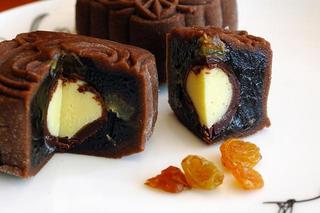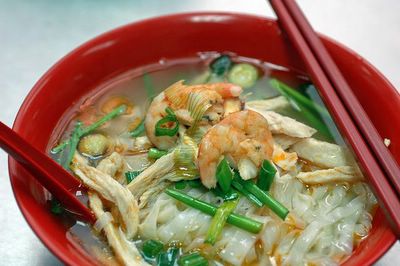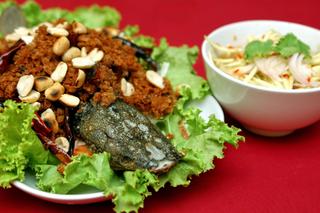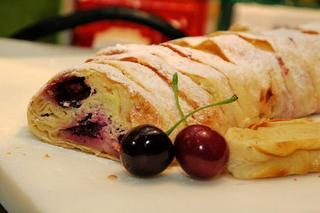
Nutty delight...you can't go anymore traditional than this!

Chocolate in your mooncake anyone?

Mooncakes today have come a long way from its earliest version of baked pastries filled with plain sweet lotus paste. In recent years, the local mooncake market has been so lucrative that commercial bakeries and confectioneries outdo each other annually to grab a bigger slice of the market. So much so that sometimes the newer mooncake creations seem like a culinary experiment that has gone totally awry. A case of too many chefs spoiling the cake?
Here's a peep of the good and unusual ones available.
DYNASTY OF NEW FLAVOURS
Renaissance KL boasts of mooncakes with new, unusual fillings alongside the more classical variants. The innovative fillings incorporate fruity flavours such as durian, mango or orange paste, pandan lotus paste and chopped dried persimmon encased by snow skin or the chilled, unbaked skin. These are very light on the palate, with refreshing fruity-citrusy nuances coming through clearly.
There is also snow skin mooncake with green tea and walnut paste which strikes a chord with us for its mildly bitter aftertaste. Special mention must be made of the assorted baked nuts with ham mooncakes – the nutty filling is imbued with the delicate fragrance and appetizing tanginess of ‘san kat’ (wild lime) and ‘kat peng’ (candied lime pieces) in addition to the sublime flavour of Yunnan ham.
Dynasty's classic baked mooncakes are filled with either white lotus seed or pandan lotus seed paste that comes with single or double salted egg yolks. Prices range between RM7.00 and RM14.00 per piece. Specially designed elongated wooden gift boxes bearing the outlet’s Chinese fairy motif are available.
DYNASTY CHINESE RESTAURANT (non-halal)
Renaissance Kuala Lumpur Hotel
Corner of Jalan Sultan Ismail & Jalan Ampang
50450 Kuala Lumpur
Tel - 2771 6773
TEA AND FLORAL INFUSIONS
Dim sum chef Leong Kok Meng rises to the occasion with two distinctive flavours that unmistakably exude the mooncake’s Chinese origins.
Sweet osmanthus or ‘kwai fah’, a native Chinese flower that is favoured for its heady peachy-floral scent is used to imbue the lotus paste filling. However, the sweet osmanthus flavour is barely discernible. It would have come across better if the lotus seed paste has been used on its own instead of being added with the salted egg yolk. Still I discovered a nice peachy aftertaste lingering in my throat after eating two wedges of the said mooncake.
Much loved by Chinese tea connoisseurs, the Pu Er tea is Chef Leong’s choice in the making of his smoked ‘Pu Er’ Mixed Nuts mooncake. These robust, earthy tea leaves and hickory wood chips lent their lovely aromas to the smoked assorted nut mixture for the mooncake filling.
Other varieties available include plain red bean paste in either baked or snow skin, pandan lotus with single yolk and snow skin mooncakes with lotus paste and salted egg yolk. Spring Garden’s mooncakes are priced from RM11.00++ onwards per piece depending on the variety.
SPRING GARDEN RESTAURANT (pork-free)
Crown Princess Kuala Lumpur
City Square Centre
Jalan Tun Razak
50400 Kuala Lumpur
Tel – 2162 5522 ext 5511
FOREST BERRIES AND MORE
Hong Kong chef Chan Kong Tung and dim sum chef, Chan Teck Woo put their heads together to conjure up fillings made from forest berries, white lotus seed with ginseng, golden custard with sweet corn and cheese with honey and walnut amongst others.
Made from strawberries, raspberries, cranberries and cherries, the mooncakes' sweetness is tempered by the berries’ tangy nuances.
Less extreme but equally interesting variants include mini snow skin with green tea, coffee or chocolate-whiskey fillings. Otherwise, you can’t really go wrong with traditional temptations like the Hong Kong white lotus seed paste with single yolk and pandan lotus seed paste with single yolk mooncakes.
Prices for Tai Zi Heen’s mooncakes range between RM8.00++ and RM14.00++ per piece.
TAI ZI HEEN (pork-free)
Prince Hotel & Residence Kuala Lumpur
Jalan Conlay
50450 Kuala Lumpur
Tel - 2170 8888 x 8200



































